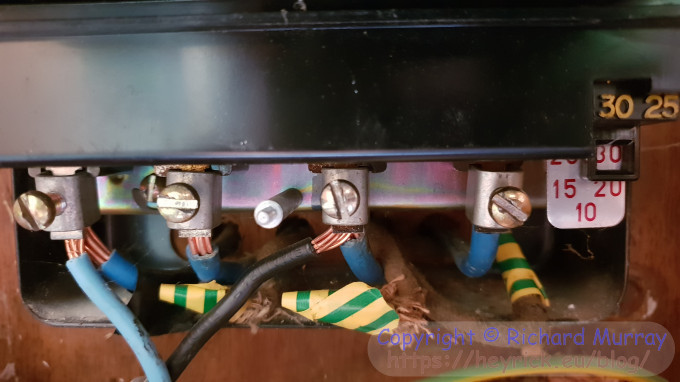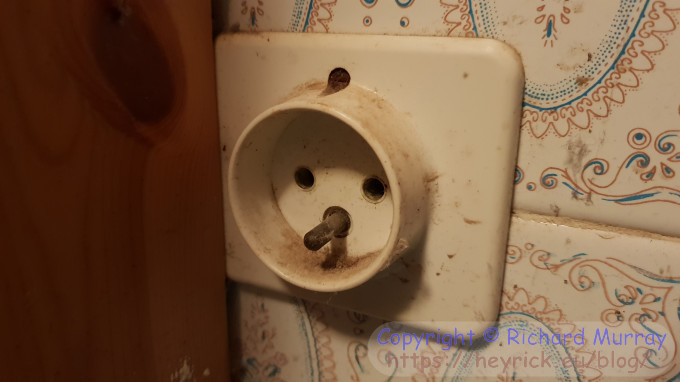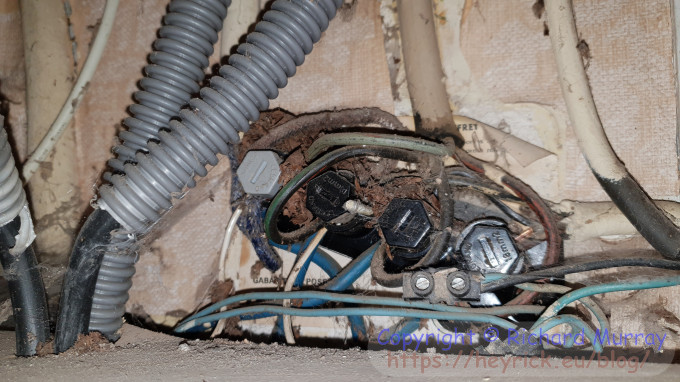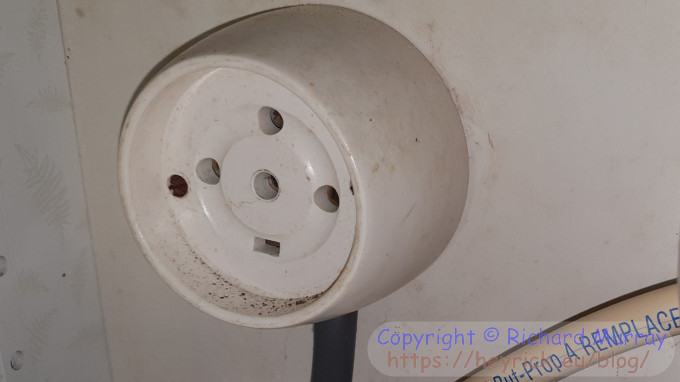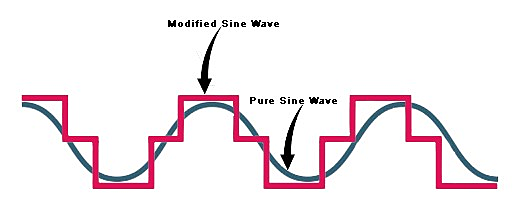Fun with electrics
|
|
Moved from the Wake-On-LAN discussion, because, Aldershot… Well, this all sounds delightfully modern. Allow me to show you the bottom end of my 640mA trip switch gizmo.
The terminal on the left is Neutral. The other terminals are Live. The thing on the far right with the numbers is an overcurrent cut-out. In France, domestic electricity is sold according to consumption. I am on a 9kW tariff, which means that I can use up to 9000W. If I go over, the power cuts out. We were on 6kW (cheaper) but with a 2kW water pump, a 2kW kettle, a 2kW immersion heater, a 2kW oven, a 1.5kW hairdryer, and a 1kW room heater…not to mention lights and computers, it was a lot of juggling to work out what could be on when. With 9kW, there’s leeway. I think the most I use when not trying is maybe 6kW (if the pump, water heater, and kettle are all on together). I can only use 3.5kW maximum in the kitchen as the power there is provided by an extension lead run through from the bedroom, and the lead is rated 3.5kW. The cables wrapped in earth-colour tape are some old rubber-fabric cables that were wired to the outbuildings. Something was letting water in out there, causing the electricity to trip out, so I figured the simplest solution (since I have exactly zero need of three phase in the shed!) is to simply disconnect all of that stuff. I’ve wrapped the bare ends in tape (earth colour was all I had to hand) because it’s not possible to bend them away, the rubber crumbles. Anyway, most of the sockets around here are two pin. Either little ones or regular sized ones (which will roughly correspond to the 5A and 13A sockets the UK used to have in the days of round pin plugs). Then there are horrorshows like this. This socket is at floor level, and is in the bathroom about a metre away from the bathtub. Given it might be fabric/rubber wiring, I’m not touching it. Not going to open it up to try to figure out what the earth is connected to, if anything. It’s okay, I’ll wait while you go and put the kettle on and swear under your breath. . . The only earthing connection I know of is around the side of the house, it’s bonded to one half of the phone line wiring through a 20A fuse. I’m not even going to ask about that either. So when the bedrooms were “renovated” in 2002 (basically a replacement tile floor and sticking up a metal cage with plasterboard screwed to it), new sockets were provided. That’s the blue/black cable pair going down. Blue for neutral, black for live. I wanted brown, but the DIY shop didn’t have any. It isn’t possible to use CPL here, as the bedrooms are on a different phase to the living room (where the Livebox is). The Livebox is not earthed (and using a power brick, there’s no provision for that). Plus, a lightning strike (I suspect to the phone line) about a decade ago wiped out the Livebox that I had at the time, and everything that was connected to it except the rotary dial phone (Socotel S60?) that just shrugged off the impact. The Livephone transmitter and regular phone were all bulging and burnt out, not to mention that it looked like somebody took a flamethrower to the router’s insides. So, with all of this in consideration, my setup is a strictly WiFi one. There’s no direct electrical connection between any computer and the outside world, other than the power. If such a connection was necessary, I would agree with Steve in that fibre optic is the only safe way. A long stretch of Cat5 might “do the job”, but it’s risky for anything more than a quick five minute patch. As I write this, I am sitting out in the west grassy bit (to be out of the wind, which is still quite chilly). The network… well… Uh-hu. The Livebox in the living room is connected to the Vonets router in the bedroom which is connected to the Verbatim MediaShare gizmo pushed into a slot in the roof of an outbuilding which is connected to my tablet around the end of the house and the cow barns. So that’s a few hops the signal has to do to get from the router to me. It does work, although it’s a little slow. I get 0.94 megabits down, and 0.2 megabits up, with a 29ms ping. |
|
|
Yup, it’s the MediaShare. I went and stood beside it, switched my phone to pick up from the Vonets, and I got 16ms ping with 3.26 megs down and 0.65 up. Which is about the speed that my broadband is running at today. I’ve been looking at an AC600 outdoor repeater (the 2.4GHz/5GHz one). Basically, something like this: https://www.amazon.co.uk/dp/B07SBMKHHJ |
|
|
I assume you live in France where such lash ups are allowed. I knew the French must be sitting on a pile of crap when they criticised our 30A ring main system with plugs locally fused. Not perfect but we had standard colours (red live black neutral and green earth) in the 1960s. The surviving electricians who were colour blind were looked after with a change to brown, blue and striped green/yellow. Since then we have stupidly changed the colours of three phase live conductors from red, blue and yellow to colours including black. |
|
|
What are you planning to do with the WiFi repeater – cover the garden/field – use someone’s else WiFi :-| |
|
|
Yes and no. Any and every electrician would be jailed if they tried something like this nowadays. There are very strict regulations on what is allowed, which with why new installations have many many trip switches. A fuseboard that looks like it belongs on an airplane. However, back in the mid ‘60s when this place was connected to electricity, I’d imagine things were a lot more relaxed. The more recent revisions (80s?) were likely done by the farmer himself. Aside: I’ll give you a hint – the tea shop lady in town can make cakes, but she cannot make a carrot cake. Why? Because being a “patissier” is some sort of protected occuption. Only a trained and qualified patissier is allowed to make a cake, put icing on it, and then sell it. She, not being qualified, can make a cake but not ice it. It’s unclear if she is even allowed to call it “cake”, so she has a lot of creative names.
Not so different to a farmhouse my mother looked into buying in Cornwall in the late ’80s. By the way you want to talk about crap? Why not explain that awful thing that I’ve seen used in the UK that plugs into a bulb holder to allow a person to hook up stuff like an iron instead of a 60W light. That’s not only crap, that’s potentially overloading wiring intended for lighting circuits.
The logic behind the fused plugs is that the equipment itself should carry a sufficient fuse (or other sort of protection). It has often been said that the 13A fuse in a plug is intended to protect the cable. Against what? Most of my equipment, when I was in the UK, had all of the 13A fuses replaced with 3A ones (or 5A for the monitors). So, what exactly was the 13A about? As for the ring main, the criticism of this is bloody obvious. You have a primary wiring circuit intended for… I forget the exact values, so let’s just say a 30A load. The usual sorts of crap that people have in their homes these days. In order to make it less expensive (people talk of copper shortages following the war, but I don’t know if that’s an urban myth) the circuit is wired up as a big loop with cable capable of carrying, say, 15A or 20A. The idea is simple. You wang in a heavy load appliance like a kettle or hoover, the load is dispersed in both directions back to source, so in effect it’s 15Ax2 or 20Ax2 which is quite capable of handling 30A. The problem is that it is not fault tolerant. One big ring connected at each end to the fusebox will show exactly zero indication of a break in the wiring (maybe a socket wired up badly?). All of the sockets will still work, as it would require two breaks to take out any of them, but most importantly you now risk overloading the wiring as the current is no longer able to flow in both directions. Over here, as far as people have told me, the layout is quite simple. One fuse thingy provides power to three sockets. As there are six sockets in the bedrooms (three at the front, three to the back, split between mom’s room and mine), these are two separate runs of wire passing through two separate… RCCB? I forget the initials. Basically an automatic fuse. There should be a low current trip in there too (because the 650mA of the main cut-out is far too high for us meatsacks) but there literally isn’t any space in which to fit the things. Trust me, if this place was rewired (at hideous expense) to current standards, I would not have four trips, I would have about fifty. I would even have different colours for the phases (brown, grey, and black).
Over here, before the introduction of legislation (NF C15-100 in 1970), it appears that it was typical to have: green or yellow (not green and yellow) for live, grey or white for neutral, and black or red for earth. Hmm, a brief look at the overview of C15-100, it looks as if the standard specifies a lightswitch for a light and a 16A socket in there too. It’s unclear if it should be near to the light switch, or if there should be a second one there. Haha… six sockets in the kitchen. I run an extension lead through because the one regular socket is broken.
Stupidly? Neutral is blue. Earth is green and yellow. Always. [note there is some crossover with PEN setups where Earth and Neutral are joined, so a blue wire with green/yellow tape at each end (or vice versa) may be encountered] Phase colours are brown for the first phase, black for the second, and grey for the third. If it’s a single phase hookup, then brown is used (regardless of which phase it actually taps into). With some noted exceptions (America, Canada, Japan…) this is expected to be an international standard. But it doesn’t do much for the |
|
|
Like Chris, I recall the major noise made by Europe and particularly France about English electrical standards. Even at the time I suspected a large amount of hypocrisy.
I suspect Rick is a bit far from others to get any connection, even with a Pringle tube antenna enhancer. In total contrast one of the desktop support staff had free wifi for years – lived directly behind one set of residences for Warwick University |
|
|
Whose? When mom was alive, we tested Baofend F888S walkie talkies. I went for a walk in various directions. They claim a 3KM range, but it’s closer to 400 metres when you take walls and trees and such into account. I got a longer whip antenna for mine. Didn’t seem to make any difference. Never got to test a second antenna (on both) because, well, you know why… :-( |
|
|
Standard politics. “We’re right and you all suck”. Electrical standards, vaccine distribution, you name it. I think the crowning glory of the EU is managing to exist at all. But, of course, these days it’s just another layer of “We’re right and you all suck”. |
|
|
Most of my equipment, when I was in the UK, had all of the 13A fuses replaced with 3A ones (or 5A for the monitors). So, what exactly was the 13A about? A three bar electric fire (3kW) or a kettle. Nearly everything else should have a 3A, 5A or 10A fuse. 13A was the biggest allowable so plugs were sold with a 13A fuse. Now appliances have to have a plug included before sale, things have improved. In order to make it less expensive (people talk of copper shortages following the war, but I don’t know if that’s an urban myth) Nor do I but it was for cheapness at a time when people had not much to plug in – wirless and TV and a 3-bar heater. Fixed stuff like immersion heater, storage heaters or electric cooker had to have a separate circuit. The theory was, I suppose, largest point load 13A and having more than two double sockets in a room was unusual. In the 1960s my bedroom was unheated (as were all the bedrooms, although one had a gas fire) and the main heating in the kitchen was a back boiler and a coal fire in the dining room. Not sure why the requirements have not changed now that people have so much stuff … |
|
|
Since the wavelength would be roughly 66cm, even a quarter wave whip would only be about 16.5cm long, so I would expect a longer whip to make things worse rather than better – if anything, and it’s very difficult to do a proper comparison when RF is involved, especially at such high frequencies. |
|
|
Since we’re in Aldershot… ;) You mentioned vaccine distribution. Here in NZ we have twenty different “District Health Boards” (which, naturally, do not geographically match with the sixteen “Local Government Regions”). Central government announced a vaccine rollout schedule that puts everyone into one of four groups. Currently if you’re in group 1 or 2 you can get a vaccine, but if you’re in 3 or 4 then you need to wait. Unless you’re in Northland, as the DHB there has thrown out the official schedule and is giving vaccines to anyone that comes through the door. I just wonder how long it’ll be before other DHBs start coming up with their own ideas and we go from a clear rollout schedule to “it depends”. Now back to your electrics discussion… |
|
|
I was surprised when I first moved into the flat we lived in when I was posted to Germany (1979-82) to find it had an unswitched mains socket in the bathroom. It was a big bathroom and we put the washing machine in there as there wasn’t provision for it in the kitchen. The other choice was down in the cellar, but as we were four floors up that wasn’t going to be practical. The rules on electrical wiring and socket placement on the continent do seem to be more lax than here. I never really liked unswitched outlets – I prefer them to be switched off before plugging/unplugging stuff. |
|
|
You are joking? Three phases in one buildng is too lethal.
It is a while since you were in the UK. |
|
|
Literally the first picture in this topic is four wires out of the bottom of the master trip switch….? Okay, well, if you want joking – here’s the distribution panel above the meter.
The three wrapped wires on the left are new things, the two sets of sockets in the bedrooms and the immersion heater. Fuses? What fuses? =:-( Here’s a nice fully wired (P+P+P+N+E) socket in the kitchen.
There used to be one in my bedroom and two in mom’s (those since removed). There is one or two in the living room. I know there’s one (P+P+P+N) by the window, I think there might be one around the back behind the boxes of stuff. And, of course, numerous outside in odd places. Like one directly beside a downspout that overflows when it rains really hard. Thankfully that had a bank of fuses, so taking out the fuses and adding little rubber seals (stolen from gardena hose attachments) meant the power didn’t trip out every time it rained hard. :-/
Three phases in old farmhouses is extremely common. I’m guessing once upon a time, things like ovens and washing machines worked on three phase? We use three phase extensively at work. Motors run smoother and cooler, and actually remarkably small motors can be pretty damn powerful when running on three phase. Technically there’s no such thing as a single phase motor because there’s nothing to set up a rotating magnetic field when there’s only one phase. Instead, and in order to even get the motor started, a second phase is usually faked using a capacitor. Some interesting things about single phase motors is:
#include Standard disclaimer about sticking soft fleshy parts into devices that may spin up a 5kg load at 1200rpm.
If people are going to judge French wiring standards by the abominable crap that happened in the late ‘60s, then allow me to point out that “in the past” a lot of nasty stuff happened. That’s why we have such strict standardisation nowadays. |
|
|
Mostly all this is a bit heigh ho to someone used to Indian electrical installations, but this bit jumped out at me:
Indeed it is not the same, and it’s a very subtle way of cheating the consumer. If – as with most electrical devices apart from heaters – the current and voltage are not closely in phase, they’re stealing. |
|
|
Fun with electrics? Do you need a sign for your front door?
What voltage is your supply? |
|
|
By what percentage? Assuming an average bit of string |
|
|
Assuming a linear load (i.e. sinusoidal waveforms) the net power delivered varies according to the cosine of the phase angle between voltage and current. If voltage and current are in phase, the net power delivered (in Watts) is equal to the VA reading. If voltage and current are 90 degrees out of phase, the net power delivered (in Watts) is zero, but the VA reading is a very long way from zero. In other words, the percentage could be anywhere between 0% and 100% depending on what types of device are being powered. For more details, see the Wikipedia article on power factor |
|
|
I’ve found a few surprising things when we moved into our current UK house (Built 1970, and extended before we bought it in 1980). For example a cable departing from a 40amp fuse, and appearing – nowhere. I think it belonged to something that was moved when the house was extended, so probably ends embedded in the plaster somewhere. Then there was the downstairs ring main which has 14 sockets, and a broken neutral. The neutral was broken where it was enclosed in the boxing of an internal downpipe, and one of the nails has gone cleanly through the neutral, avoiding the line and earth. The landing light was interesting. It was fed from the upstairs lighting circuit, to a two-way switch, then twin (red and black) cable to the downstairs two way switch, and finally to the neutral of the downstairs lights. Which meant that when working on the downstairs lights, the neutral could become live. I did quite a lot of re-wiring. I had had practice rewiring. Our first house was built by a local builder to my grandfather’s design in 1949. The builder hadn’t got the hang of this new-fangled ring main system, so the house has eight 15 amp sockets, each powered directly from the fuse board. Each circuit had line and neutral fuses. The fuseboard in turn was connected to a large circuit breaker on the incoming feed. All the wires were rubber covered. Eventually the shortage of sockets (that had resulted in christmas-trees of adapters) decided me to rewire completely. In the process I discovered that some new wiring, that had been put in for the conservatory, ran under the landing floor, in shallow grooves in the top of the joists. The floorboards and carpet were nailed down, so the nails could easily have punctured the wires. We regularly walked barefoot along that landing. The best bit however came when I removed the old fuseboard. I unscrewed it from the wall, and when I pulled it clear, still on the wires, the insulation stayed stuck to the wall. The rubber had completely perished. |
|
|
It’s a long time since I actually measured any power factors – not since about 1981 I think. Heaters, cookers and kettles which are basically big resistors have power factors of 100%, always have had and always will. Other things may have changed a bit since 1981, as designs change. Motors have high power factors when just starting up or working hard, but can get down to about 15% when just spinning fairly freely; electronic equipment varies a lot – and is quite likely generally different from how it was in 1981. Old fashioned linear power supplies and early designs of switched mode power supplies sometimes have power factors quite a bit greater than 100% – which doesn’t sound possible, and wouldn’t be if the current drawn was a phase-shifted sine wave, but if you have a narrow current peak at the voltage peak, and zero or near-zero current the rest of the time, the power factor can go way up. I measured one at Microvitec that was over 115%… More modern switched mode power supplies are probably better, and get the power factor close to 100%, and very likely somewhat lower. I understand how you’d design to do that, but I’ve not actually tested any. Transformers basically pass the power factor of their load back to the supply – except, like motors and for the same reason, when they’re lightly loaded, when they’re basically inductive loads (with a phase lag). Capacitors give a phase lead – except when fed through a diode and charge at voltage peaks, as they often are in electronic PSUs… But if your home is electrically heated (other than with heat pumps, which are motors) your power factor overall all will be close to 100%. Otherwise it could be anything from 15% or so to almost 100%, depending what you use electricity for. My fridge in 1981 had a power factor of 100% at start up every time it cut in, dropping rapidly to 25% where it remained until it cut out again, averaging very close to 25%. At 75W it doesn’t sound like a big part of my consumption, but since it was on for about 30% of the time, all day every day, it used a lot more than my 3kW kettle for example. I suspect but don’t know that more modern fridges have somewhat higher power factors. That one was far from new in 1981. |
|
|
In our office building we had, downstairs, a large electronics test area, and the computer room. Ther test area was fed from one of the three incoming phases. The other phases phase fed the upstairs and downstairs offices. All three phases fed an online UPS. When 3-phase is rectified the result is DC with very little ripple – as least that’s the theory. The UPS had a big bank of car batteries in series, fed with the rectified 3-phase. At one of the UPS services, the technician wondered why the batteries had started to fail. Eventually he got his oscilloscope on the case. It turned out the DC power supplies in the test area were clipping the mains input, because all their current draw was at the peak of the sinusiodal voltage. That phase looked a bit like this: That’s bad enough. However with 3-phase the neutral tends to move towards the average of the three phases. As a result the other phases, that fed the offices, looked like this: The rectified result had a LOT of ripple, and it was overheating the batteries. I don’t imagine the distorted phase was doing the office equipment any favours either. The computers were fine – the UPS, being online, generated its own 3-phase from a continuously running inverter, running from the batteries. |
|
|
Beware of students with an inquiring turn of mind. When on my HNC course, we were working on motors and generators. Since we are in Northampton, at the time the home of Express Lifts, the college has a Ward-Leonard set. This is a DC motor connected to a 3-phase generator. With lifts, the motor could run at variable speed, thus generating variable frequency AC. This was fed to an AC motor running the lift. However for this experiment we were investigating a synchronising device, consisting of three light bulbs, each connected to a generator phase and the building supply phase. The idea was to synchronise the speed of the generator, indicated by the lights being steady, then adjust it to a very slow drift. When all the lights were out, the generator was synced to the mains, and the switch could be closed connecting the two. This allowed the machine to put power into the grid. The instructor then took a coffee break. Being curious we wondered what would happen if the switch was closed when they were out of phase. There was a heavy thump from the generator, shaking the floor, and the lights flickered. The generator had had to add another 60 degrees of rotation almost instantaneously. Fortunately it was well bolted down, and being an evening lab, there weren’t many people about, and importantly, not many staff. |
|
|
European standard – 230V/390V. I’ve rejigged the bits above and added more photos and such for a blog article: https://heyrick.eu/blog/index.php?diary=20210502
Would you care to explain how a spinning disc meter is capable of recording watts? As I understand it, volt amps is a way of measuring how much electricity is used at any given instant. Converting that to watts requires knowing the power factor, as you mention, which depends upon whether it’s an inductive or resistive load. How would a meter be able to detect this, especially considering there are dozens of things plugged in at any given time.
One of my first jobs was builder’s cleans (circa 1991). Nothing you say surprises me. I’ve seen people wiring up stuff that I wouldn’t trust to put batteries in a torch, never mind light switches. We used a cute vacuum cleaner called Henry. It was regular practice to pop a socket tester into the socket before plugging anything in. The tester was attached to Henry with sticky velcro.
But isn’t the AC power generated by most UPSs a square wave swinging both ways to fake something akin to the expected sine wave? Like this:
|
|
|
As I suspect we both think, they would only record amps. The voltage would be assumed. Interestingly, my solar panel system has a display of watts generated. At night it shows 48 watts. I assume this is indicating 48 watts is passing between the panel controller and the house, but in the reverse direction. It’s displaying amps multiplied by assumed voltage, without considering relative phase, which would give the direction. I could therefore save myself some overnight electricity by adding a relay in the line, controlled by a photocell to power off the solar panel controller when it’s dark.
It is. However the office power wasn’t from the UPS but from the normal, and hence distorted, supply. The UPS was a 25KVA item specifically specced for a computer room, so I believe it was rather better filtered than that. |
|
|
No. The spinning disk is a real energy meter. It measures (actually integrates over time, of course) the instantaneous product of the voltage and current. That’s why it need a neutral connection as well as input and output of the live connection. |
